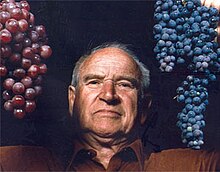Douce noir
| Douce noir | |
|---|---|
| Grape (Vitis) | |
 Douce noir/Bonarda grapes growing in Argentina | |
| Color of berry skin | Noir |
| Species | Vitis vinifera |
| Also called | Bonarda, Corbeau, Charbonneau more |
| Origin | Savoy |
| Sex of flowers | Hermaphrodite |
| VIVC number | 2826 |
Douce noir (also known as Bonarda, Corbeau and Charbono) is a red
It arrived in Savoy in the early 19th century, and by the end of the century it was the most widely grown red wine grape in the region. It is the second most widely planted red grape in Argentina (after
In California, Bonarda/Douce noir/Charbono is produced in very limited amounts with the grape having been described as a "cult wine" for its scarcity and devotion of its connoisseurs.[2] However, journalists such as Alan Goldfarb describes the variety as "... the Rodney Dangerfield of wine" and notes that it is a hard variety to find a market for.[3]
History and origins

Some of the early synonyms of Douce noir, Plant de Turin and Turin, hinted that the grape have originated in the
In Savoie, the earliest mention of the grape variety dates to a letter written on November 24, 1803 by the mayor of Saint-Pierre-d'Albigny to the prefect of Savoie describing the grape varieties growing in his commune. Other documents showed that Douce noir was also widely planted in the communes of Arbin and Montmélian and by the end of the 19th century it was the most widely planted red grape variety in Savoie.[1]
Douce noir was also found outside of Savoie, particularly in
Discovery of other plantings
While plantings of Bonarda/Douce noir dwindled in Italy and France, DNA research of grape varieties in other wine growing regions revealed that the grape was more widely planted than originally thought. In 2000 DNA analysis revealed that the Turca grape growing in the
Viticulture and relationship to other grapes

Bonarda/Douce noir is a
In California, many of the Bonarda/Douce noir/Charbono
Despite sharing several synonyms and often being confused for one or the other, Douce noir has no known relationship to the Piedmontese grapes Dolcetto and Bonarda Piemontese nor to any of the other Italian varieties that have Bonarda as a synonym such as Croatina and Uva Rara. It also has no known relationship to Douce Noire grise an old French variety that according to ampelographer Pierre Galet is no longer cultivated.[1]
Wine regions
Today Douce noir is far more likely to be found in the
In Argentina, the 18,759 hectares (46,354 acres) of Bonarda/Douce noir makes it is the second most widely planted red grape variety in the country after Malbec and representing 8% of the country's total vineyard plantings.[5] The vast majority of the plantings are in the Mendoza wine region but significant plantings can also be found in the La Rioja, San Juan, and (the relatively unknown) Catamarca provinces. Here the grape is used for both blending (sometimes with Malbec or even Cabernet Sauvignon) but also as a varietal wine that Master of Wine Jancis Robinson notes has the potential to be of high quality.[1]
California Charbono

In California, where the grape is known as Charbono, the variety has a long history in the Napa Valley where it was an important variety for producers such as
In 2008, there were 36 hectares (88 acres) of Bonarda/Charbono/Douce noir with nearly half of those plantings in Napa Valley, particularly in the warm
Styles

In the Old World wine regions of France and Italy, Bonarda/Douce noir is often used as blending grape contributing to the
In Argentina, varietal examples of Douce noir/Bonarda are similarly characterized by a deep purple color with notes of
Bonarda/Douce noir lends itself to moderate
Synonyms
Over the years Bonarda/Douce noir has been known under a variety of synonyms including: Alcantino, Aleante, Batiolin, Bathiolin (in
References
- ^ ISBN 978-1-846-14446-2
- ^ a b c d e f g Patrica Savoie "Charbono: A Grape Struggles to Avoid Extinction" Wine Business Monthly. May 2003 issue. Accessed: April 27th, 2013
- ^ a b Alan Goldfarb "Charbono: The Misunderstood Grape Breaks Through…Barely" Appellation America, January 25th, 2008
- ^ a b Richard Nalley "Paging Charbono and Mencia" Forbes, October 10th, 2009
- ^ ISBN 9781402786259.
- ^ Appellation America "Charbono" Grape profiles. Accessed: April 27th, 2013
- ISBN 0-15-100714-4
- ^ Vitis International Variety Catalogue (VIVC) Douce noir Archived 2016-03-04 at the Wayback Machine Accessed: April 26th, 2013
